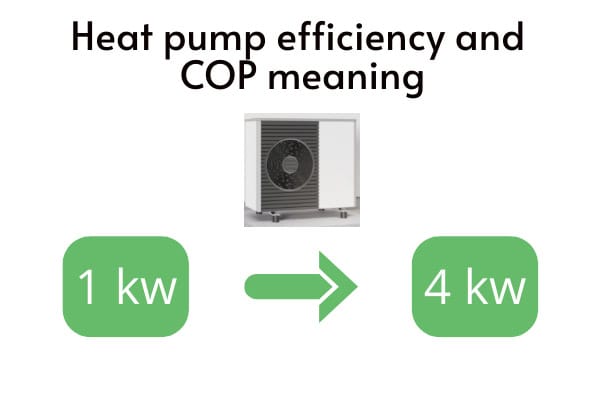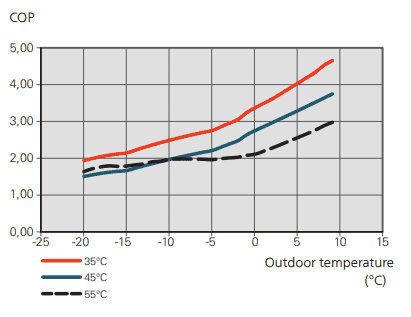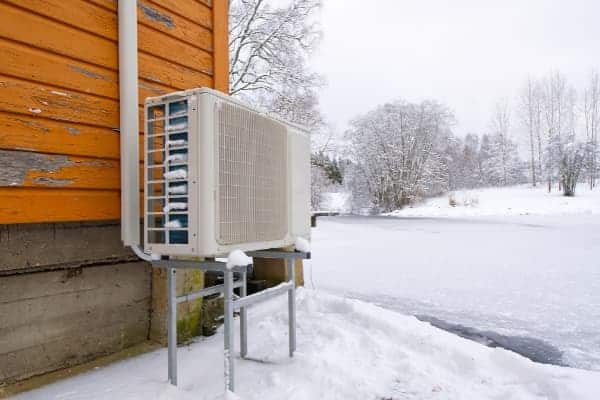COP heat pump meaning
The efficiency of heat pumps is measured with a value called COP, which stands for coefficient of performance. Before you decide which heat pump to choose, you want to ensure that the heat pump is as efficient as possible, which the COP value can tell you to some extent. This value could be named in three different ways:
- COP – coefficient of performance
- Efficiency
- Heat factor
The COP value is calculated by examining how many kilowatts the heat pump can generate per kilowatt consumed. At a COP value of 4, this means that the heat pump generates 4 kW per kW consumed. This means that the higher the value of the heat pump, the better its efficiency. The heat factor usually varies between 1 and 5, depending on the type of heat pump and model.
Since 2011, manufacturers have been required by law to state the heat pump’s COP, to simplify comparisons between different models. The COP value is measured under specific conditions in a laboratory environment and therefore does not necessarily represent how efficient the heat pump will be in your home. To know how good the average efficiency is over a whole year, the designation SCOP is used instead.

SCOP heat pump definition
Unlike COP, SCOP measures the heat pump’s efficiency over an entire year, taking into account real conditions – for example, how the outside temperature changes with the seasons. It is fairer. This value is therefore usually lower than the heat pump’s COP, as the effect decreases during the winter months. Typically, air-source heat pumps have a SCOP of around 3, while ground-source heat pumps can generate around 4 kW per kilowatt consumed.

SCOP stands for seasonal coefficient of performance and is also called annual heat factor. As an example, the average annual heating factor in twenty households with geothermal heating gave an average value of SCOP of 2.7. This means a saving of 68 percent compared to if the houses are heated with fossil fuel.
As of January 2013, rules have introduced the SCOP of heat pumps. This leads to it being easier for you as a consumer to compare different models of heat pumps, as this value is more representative than the COP value. SCOP is also usually measured in a laboratory environment, which means that the value does not necessarily correspond to the effect that the heat pump will have in your particular home.
The table below shows the differences in the annual heating factor for air-to-air heat pumps depending on the outdoor temperature.

The best heat pump does not always have the highest COP
There are other factors to consider besides the efficiency of the heat pump. COP is measured under specific conditions, which for example for a ground source heat pump can correspond to an outdoor temperature of 0°C and a supply temperature of 45°C in the radiators. If you live in an area where the temperature drops to -20°C during large parts of the winter, the heat pump will not be as efficient there.
Therefore, check which heat pumps work well corresponding to the climate conditions that prevail where you live. A ground source heat pump or air-to-water heat pump often has a higher COP in combination with underfloor heating compared to radiators. However, the heat factor is also affected by the supply temperature in the distribution system.
The higher the temperature difference between the outside and inside, the worse the efficiency. Depending on whether you have air-borne or liquid-borne heating, the temperature difference is affected in the following way:
- Airborne heat The temperature difference between the outdoor and indoor air must be as small as possible for optimal effect.
- Liquid-borne heat The temperature difference between the heat pump’s coolant and the supply temperature of the radiators or underfloor heating should be small to achieve maximum heat factor.
This means that the efficiency of the heat pump decreases with low outdoor temperatures and high indoor temperatures. Therefore, this is important to take into account if, for example, you prefer more than 20°C indoors, because otherwise it is counted as a standard value for indoor temperature.
COP value for different types of heat pumps
Many manufacturers often state that their heat pumps have a COP of 4 or even 5. This means that this value has been achieved under controlled and specific conditions. As previously mentioned, air-source HVAC often has a lower COP compared to ground-sourced. This is because air-sourced are more sensitive to temperature changes.
It is important to review the efficiency of each type of heat pump, but do not let this guide the choice of installation. Considering that air-to-air heat pumps are considerably cheaper than, for example, a ground source heat pump, this can be a good investment for a smaller house, even though the COP value is lower.
Regardless of the choice of heat pump, there are three things you can keep in mind when comparing the COP value between different heat pumps:
- Check which outdoor temperatures were used in the calculations of the COP value. These should, if possible, be applicable to the region in which you live.
- Is the electricity consumption for the circulation pump and fan system included in the electricity consumption? If this is not taken into account, the total energy consumption may be higher than what is stated in the product description.
- Depending on how the measurement was made, peak energy may be included in the calculation. Peak energy is the supplementary electricity used during the coldest days when the heat pump is unable to generate enough heat.

The distribution system supply temperature affects the COP
Do you have a waterborne distribution system? Then there are some details worth considering before buying a heat pump. Among other things, this concerns how high the supply temperature is in radiators or underfloor heating. As a low-temperature difference often means a higher heat factor, this would lead to radiators with low supply temperatures being more efficient compared to higher supply temperatures.
Common measurement values for evaluating the efficiency of heat pumps are based on a supply temperature of 35°C, 45°C, or 55°C in the radiators. Underfloor heating can have an even lower supply temperature, which is partly a reason why it usually generates a higher heat factor in combination with a heat pump. Common supply temperatures for underfloor heating are 25°C, 35°C, or 45°C.
It is not always that lower supply temperature leads to higher COP. However, several tests can show that the heat factor is often higher when underfloor heating is used, as shown in the table above. If you want to know more about the exact values for specific models, you should go and compare product descriptions on the respective heat pump supplier’s website.
- Powerful & Dependable Year-Round: 4-in-1 all-season appliance cools rooms up to 700 sq. ft. and heats rooms up to 500 sq. ft.; This unit features thermal overload protection for added safety and peace of mind
- Filters Help Extend Product Life & Performance: Dual Dust Filtration System protects the unit from dust and hair, extending product life and performance; Filters clean easily under a faucet for hassle-free maintenance
- Designed for Comfort: Enjoy a simple-to-use digital control with 3 fan speeds, advanced LCD display, a 24-hour energy-saving timer, and a remote control (batteries included)
- Auto Evaporation: Stress-free auto evaporation in cooling mode — no bucket to empty (except in areas with high humidity); Built-in dehumidifier removes up to 51 pints/24 hours with continuous drain option
- Cooling Capacity: 14,000 BTU (ASHRAE-128 Standard)/9,000 BTU (SACC BTU); Heating Capacity: 11,000 BTU (ASHRAE-128 Standard)
FAQ
What does the COP value of a heat pump mean?
As we all know, heat pumps are low-temperature systems. Low temperature is meant a maximum of 50-55 degrees Celsius on the supply line on the coldest day of the year.
Cop and location
Today’s heat pumps can perform a few degrees more at the expense of COP, which is an abbreviation of Coefficient Of Performance, simply put you can describe it as efficiency, however, the word efficiency is actually banned, because efficiency cannot be more than 1, but for the common language, it’s a word that most people understand the meaning of.
What then determines COP? For example, in the air-water system, it is the air temperature, the airflow rate, and the temperature from the heat pump to the heating system.
Today’s speed-controlled pumps are more significant than ever, something that the lady in the house usually turns to when heat pumps are discussed. But that’s where we have our COP. When it gets colder outside, the energy in the air drops and to compensate for the loss of energy in the air, the speed of the fan is increased and also then of the compressor, which has a certain stroke volume. But because the speed is increased, the flow of the refrigerant is increased. And the effect is maintained further down in temperature.
For example, Nibe 2120 with a maximum power of 12 kW gives at -18 °C as much as approx. 7 kW at 50 degrees supply temp. 15 years ago, the pumps were switched off at -7 /-10 depending on the make. It was not considered worthwhile to operate under these temperatures. In today’s pumps, the heat carrier pump is also speed-controlled and they usually control based on the so-called delta T, which means the difference between supply and return.
Do all heat pumps have the same COP value?
If you live in an area where the temperature drops to -20°C during large parts of the winter, the heat pump will not be as efficient there. Therefore, check which heat pumps work well corresponding to the climate conditions that prevail where you live.
What is a good COP value?
The COP value is a comparison between how much power the heat pump produces, against the power the heat pump consumes. A COP value of 5.2 means that the heat pump produces 5.2 times as much energy as it consumes. So, a COP value of more than 1 will tell us that the heat pump is effective, optimal effectiveness of the heat pump will be 3,5-5,5 depending on its type.
What is COP of ground source heat pump?
COP of a ground source heat pump depends on the ground temperature and air temperature. Generally, it is expected to be between 2.5 and 5.5.
How to increase COP of heat pump?
A ground source heat pump or air-to-water heat pump often has a higher COP in combination with underfloor heating compared to radiators.
